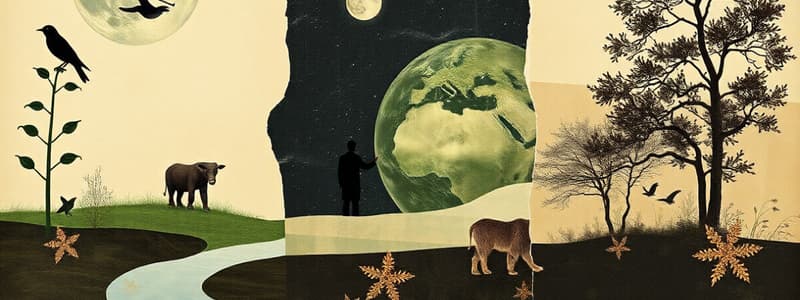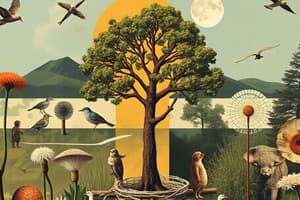Podcast
Questions and Answers
Which of the following best describes the relationship between the lithosphere, atmosphere, and hydrosphere?
Which of the following best describes the relationship between the lithosphere, atmosphere, and hydrosphere?
- They are the three components that make up the biosphere, supporting living organisms. (correct)
- They are independent entities with minimal interaction.
- They represent the different levels of the food chain.
- They are different ecosystems that compete for resources.
What is the key characteristic that defines a population, as opposed to a community?
What is the key characteristic that defines a population, as opposed to a community?
- A population refers to organisms that can interbreed with other species.
- A population is a group of organisms of the same species living together in a given location. (correct)
- A population includes all the biotic and abiotic factors in a location.
- A population consists of multiple species interacting within a specific area.
In the context of ecology, what distinguishes an ecosystem from a community?
In the context of ecology, what distinguishes an ecosystem from a community?
- A community is a larger geographical area than an ecosystem.
- An ecosystem encompasses the interactions between a community and its abiotic environment. (correct)
- An ecosystem only includes living organisms, while a community includes non-living elements.
- A community involves interactions between species; an ecosystem does not.
Which factor primarily determines the characteristics that define a biome?
Which factor primarily determines the characteristics that define a biome?
What distinguishes an ecocline from an ecotype?
What distinguishes an ecocline from an ecotype?
How does the 'fundamental niche' of an organism differ from its 'realized niche'?
How does the 'fundamental niche' of an organism differ from its 'realized niche'?
What is the key difference between hibernation and estivation?
What is the key difference between hibernation and estivation?
How does mutualism differ from commensalism?
How does mutualism differ from commensalism?
In amensalism, what distinguishes the species affected from the species causing the effect?
In amensalism, what distinguishes the species affected from the species causing the effect?
According to Gause's Law, what is the likely outcome when two species compete for the same limited resource?
According to Gause's Law, what is the likely outcome when two species compete for the same limited resource?
Flashcards
Ecology
Ecology
Study of living organisms and their environment.
Biosphere
Biosphere
Any place on Earth where living things are found, made up of the atmosphere, lithosphere, and hydrosphere.
Species
Species
A group of organisms with similar genetic characteristics that can interbreed to produce viable offspring.
Population
Population
Signup and view all the flashcards
Community
Community
Signup and view all the flashcards
Ecosystem
Ecosystem
Signup and view all the flashcards
Biome
Biome
Signup and view all the flashcards
Ecotone
Ecotone
Signup and view all the flashcards
Hibernation
Hibernation
Signup and view all the flashcards
Symbiosis
Symbiosis
Signup and view all the flashcards
Study Notes
- These notes define key ecological terms and concepts.
Ecology and the Biosphere
- Ecology studies living organisms and their environments.
- The biosphere is any place on Earth where living things exist.
- The biosphere consists of the atmosphere, lithosphere, and hydrosphere.
- The atmosphere is the layer of air surrounding Earth, containing dust, gases, water vapor, and microorganisms like bacteria and spores.
- The lithosphere is the Earth's outer crust, comprising rocks, soils, and inhabiting organisms such as bacteria, fungi, insects, and animals.
- The hydrosphere includes all water bodies on Earth's surface and reservoirs beneath it, containing aquatic organisms like green algae (Spirogyra, Chlamodomonas), protozoans (Paramecium, Vorticella), and invertebrates (Tubifex).
Species, Population, Community, and Ecosystem
- A species is a group of organisms with similar genetic characteristics that can interbreed sexually or reproduce asexually to produce viable offspring (e.g., Clarias gariepinus, Gallus gallus domestica, Parkia biglobossa).
- A population is a group of organisms of the same species living together in a specific location at a specific time.
- A community refers to the assemblage of all populations in a given area at a given time, representing a combination of different populations (i.e., different species) living together.
- An ecosystem includes the actively interacting community and its abiotic environment, where organisms interact with each other and their environment, leading to environmental changes and is the basic functional unit of living and non-living things with cyclical material exchange.
Biome, Ecotypes, Ecoclines, and Food/Feeding Habits
- A biome is a large area with fairly uniform environmental and climatic conditions, especially temperature and rainfall determining the plant and animal species (e.g., tropical and temperate ecosystems). The Nigerian ecosystem includes forest and savanna biomes.
- Ecotypes are different populations of the same species that differ phenotypically due to altitude differences.
- Ecoclines are different populations of the same species that differ phenotypically with slight genetic variation due to geographical locations and environmental/climatic conditions.
- Food habit refers to the type of food or food items an organism consumes.
- Feeding habit refers to the strategies/techniques used by an organism to handle and process food items while feeding.
Territory, Homerange, Niche, Hibernation, Estivation, and Ecotone
- A territory is an area of biological importance containing resources for survival and reproduction, guarded by the organism against conspecifics, and marked by feces, urine, songs, or colors.
- A homerange is an area utilized by an organism containing requirements for survival and reproduction, but not guarded against conspecifics.
- A niche is the total role of an organism in a given habitat, encompassing its position, activity, and relationship with the biotic and abiotic environment.
- A Fundamental or virtual niche is the space and resources to be occupied by an organism in the absence of others or competition.
- The presence of other organisms always reduces the space and resources available, and the actual niche occupied by an organism when other organisms are present is called realized niche.
- Niche size depends on the number of organisms sharing resources; the larger the number, the smaller the niche.
- Hibernation is a state of reduced metabolic activity in organisms during winter or unfavorable conditions, similar to a "sleeping stage," with organisms becoming active when conditions improve.
- Estivation is a state of reduced metabolic activity in organisms during summer or unfavorable conditions, with organisms becoming active when conditions improve.
- An ecotone is a transition zone between two ecosystems or biomes, often characterized by high species diversity, like the area between Kogi and Kano states.
Symbiotic Interactions Among Organisms
- Symbiosis means "living together," referring to any interaction involving two or more organisms, which can be categorized based on the outcome of the interaction (beneficial, harmful, or neutral).
Mutualism
- This interaction involves two organisms of different species living together with mutual benefits and the relationship is obligatory; they may not survive if separated.
- Lichen, an association between fungus and alga, is one example, with the algal cells providing carbohydrate and the fungus absorbing and retaining water.
- Leguminous plants and bacteria (Rhizobium leguminosarium) are another example, where bacteria convert atmospheric nitrogen to nitrates for the plant, and the plant provides shelter for the bacteria in root nodules.
- Mutualistic association between fungi and roots of angiosperms called mycorrhiza. The fungus extracts carbohydrate from the plants roots while it in turn supplies the plant with inorganic nutrients ad auxins.
- Another example occurs between honey bees and angiosperms (e.g., Parkia biglobosa), where angiosperms provide nectar for insects, and insects pollinate plants. Cattle and ox-peckers are yet another example; the ox-pecker feeds on ecto-parasites from the cattle body, helping the cattle in getting rid of the parasite.
Commensalism
- Commensalism is a symbiotic interaction where one organism benefits, and the other neither benefits nor is harmed.
- Epiphytic plants getting support on tree trunks are an example, with epiphytes getting support or access to sunlight without affecting the host plant.
- The relationship between shark and remora fish is another example, with remora fish getting free transportation and food scraps from the shark without harming the shark.
- Cattle walking alongside insectivorous birds (e.g., cattle egret and black magpie/piapiac) is a further example, with the birds feeding on insects flushed out by the cattle, while the cattle are unaffected.
Amensalism
- Amensalism is a symbiotic association where one organism is harmed, and the other is neither benefited nor harmed.
- In a forest with stratification, the tall stratum forming the canopy obstructs seedlings at the forest floor from accessing sunlight, potentially leading to seedling death.
- Allelopathy, where some plants discharge allelochemicals, inhibits germination/growth of lower vegetation.
- Cattle grazing in a forest can trample on insects or invertebrates, killing or injuring them.
Parasitism
- Parasitism is a symbiotic relationship in which one organism, the parasite, benefits at the expense of the other, the host.
- Parasites can live inside the host (endoparasite) or on the host (ectoparasite).
- Ectoparasites attach to the external body surface of the host (e.g., ticks, head lice) and can be obligate, always attached, or facultative, only contacting for nourishment.
- Endoparasites can be haemoparasites, found in blood tissue (e.g., Plasmodium falciparum, Salmonella typhi), or gastrointestinal tract (GIT) parasites (e.g., Ascaris lumbricoides, Taenia solium, Taenia saginata).
- Parasites are typically smaller than their hosts and do not aim to kill the host.
Cooperation
- Cooperation is a natural interaction in which organisms of different or the same species both benefit, although it is not obligatory.
- Cooperation enhances survival by providing protection, improving prey-catch, and saving energy (e.g., flocks of brain babblers or cattle, sheep, etc).
Neutralism
- Neutralism is a symbiotic relationship in which different species interact, but neither is benefited nor harmed (e.g., insectivorous birds in the same forest).
Competition
- Competition occurs when two or more individuals of the same or different species seek the same resource that is in short supply.
- Intra-specific competition occurs between organisms of the same species and is generally keener than inter-specific competition, which occurs between organisms of different species.
Gause's Law of Competitive Exclusion Principle
- Two organisms of different species depend on the same resources (in short supply). the better adapted organism will dominate and exploit the resources
- The inferior competitor may become locally extinct if the requirements for growth and development are not slightly differential or not in limited supply, they may coexist.
Predation
- Predation is a symbiotic association in which one organism, the predator, kills and feeds on the other, the prey, benefiting the predator while harming the prey.
- Some predators are specialists with specific prey species (e.g., insectivorous birds), while others are generalists with a wide range of prey (e.g., foxes feeding on rabbits, insects, and worms).
- Prey specificity is used in biological control (e.g., a species of beetle used to control water hyacinth - Eichhornia crassipes).
- Predators are usually larger than their prey, and their interactions aren't disadvantageous; long-term predators help regulate prey populations.
- Evolutionary consequences of predation include mimicry, poison production, fleet-footedness, cryptobiosis/crypsis, and camouflage.
Studying That Suits You
Use AI to generate personalized quizzes and flashcards to suit your learning preferences.




